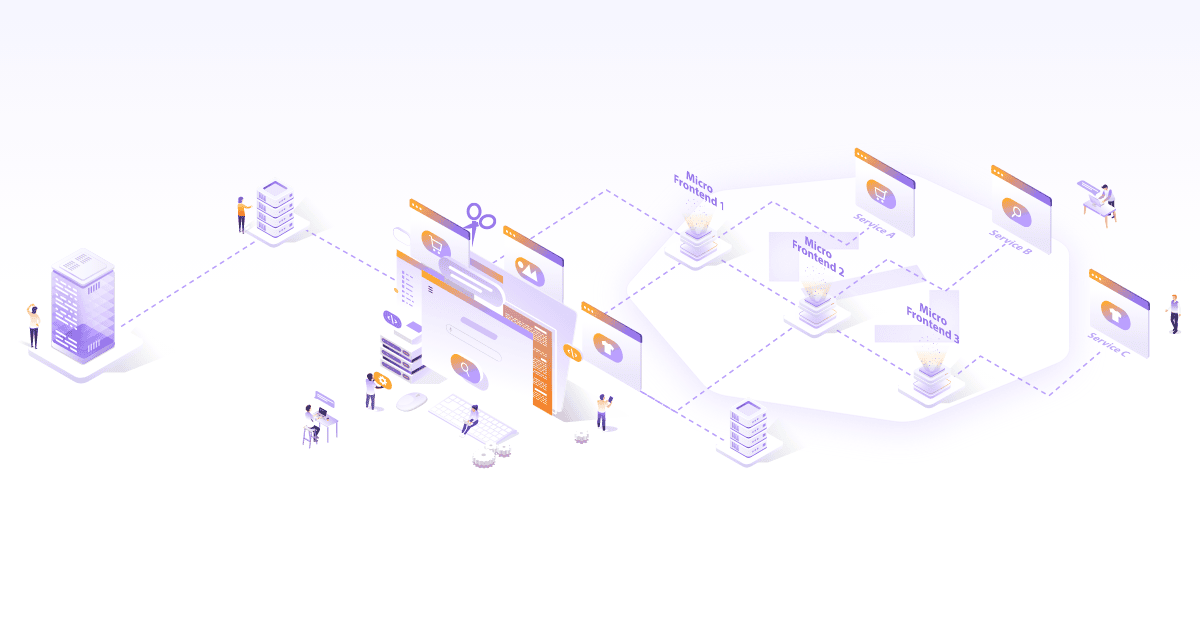
Packaging Cloud Native Applications With Gravity

How do you deliver your SaaS product in a restricted on-premise environment as identical as it is in the cloud? As a vendor how can you deliver cloud-native solutions in a regulated environment in a cost-efficient manner? As a SRE team, how do you manage your Kubernetes clusters with efficiency? In this post, we will try to explore a solution on how to package cloud native applications, which can help to answer these questions.
What is Gravity?
Gravity is an application delivery solution for cloud-native applications in a regulated and restricted environment simplifying the experience for the administrators. It provides out of the box compliance, security, and monitoring.
Gravity does this by packaging the Kubernetes cluster along with applications and their dependencies in a single file (as .tar file), also known as the gravity “cluster image”. Each Gravity cluster has a gravity daemon that acts as a Kubernetes hypervisor, monitoring the health of the cluster and re-configuring it. Each cluster is equipped with an authentication gateway that simplifies remote troubleshooting using SSH or Kubernetes APIs, even if they are behind the firewall.
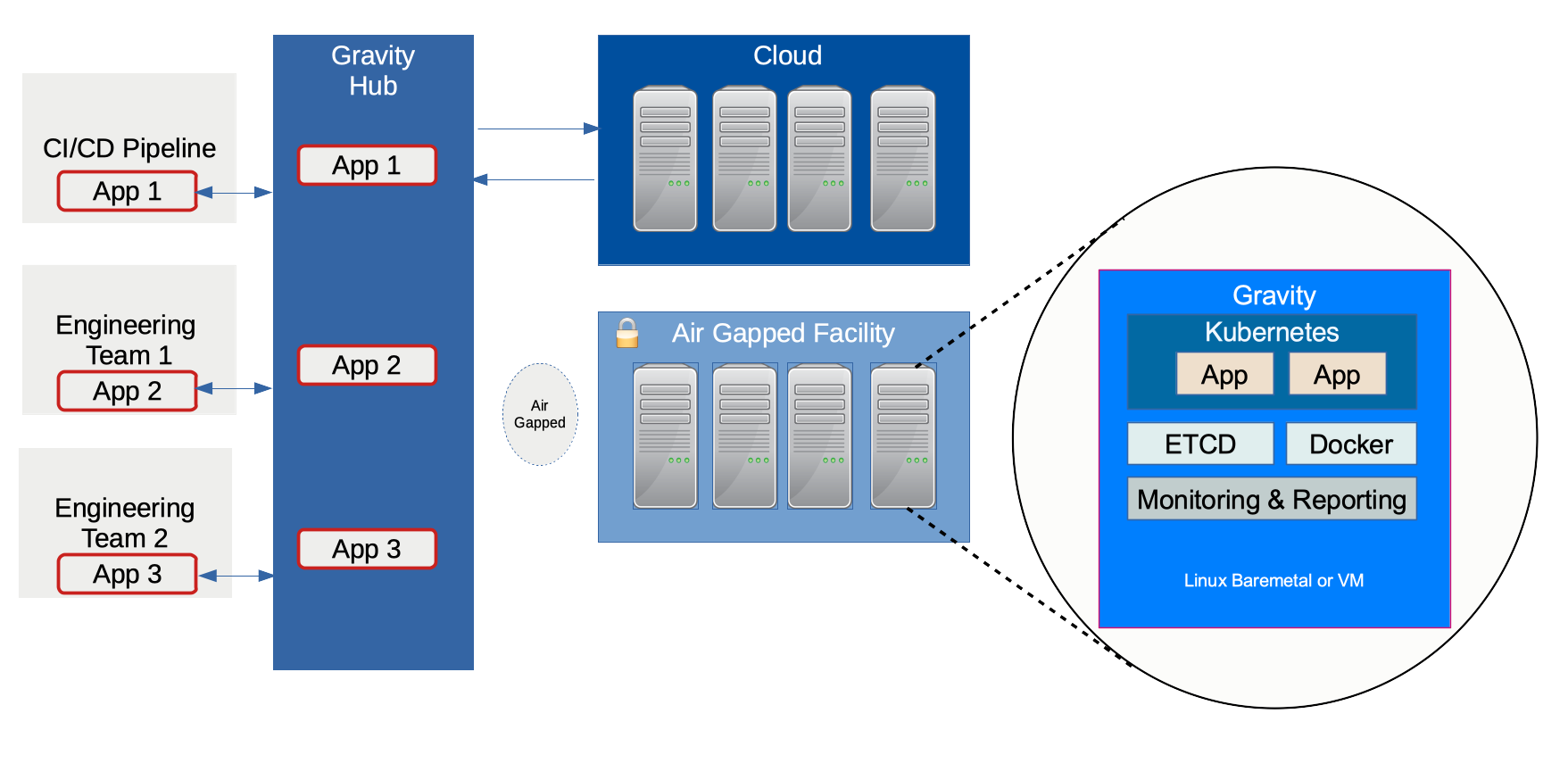
Gravity Components
- tele – this is a build tool, used to create the cluster image and publish the image to Gravity Hub
- tsh – the remote access client to authenticate against a SAML/OAuth identity provider and remotely connect to Kubernetes clusters via SSH or Kubernetes API
- gravity (service) – cluster management daemon runs on every node
- gravity (CLI) – the CLI tool is used to perform high-level cluster management tasks
- Control panel – the web GUI to administer the cluster
- Gravity hub – it is a catalog of applications and web portal to monitor and push applications to remote clusters
Gravity Workflow
Below is the lifecycle of the deployment:
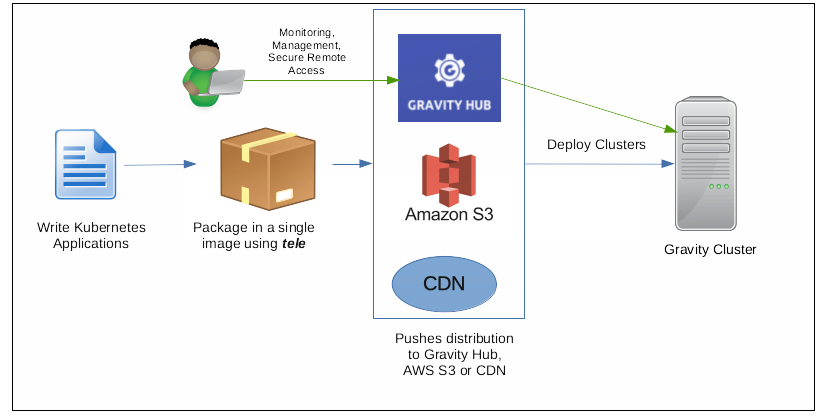
- Application developers write Kubernetes applications
- Package the applications and Kubernetes cluster in a single image (tarball) using tele command.
- Publish the distribution to Amazon S3 or CDN or Gravity Hub
- Through Gravity Hub, deploy the application in Gravity Cluster(s).
Gravity Use Cases
- Delivering Kubernetes applications to third party premises – Those SaaS vendors who want to package and distribute their applications in their client environments, either in public clouds or on-premise datacenters, can utilize this to deliver identical, out-of-the-box security, monitoring, and compliance to industry regulations.
- Multi-cluster deployments for Organization – Teams who want to deliver Kubernetes-as-a-service across multiple public cloud or in hybrid environments can package their clusters. It reduces operational overhead and brings agility to the process.
Let’s Try Out Gravity
What could be better than understanding with an example of hello world.
Pre-requisites
- An application which can be containerized
- Linux x86 VM(s) for the cluster nodes with at least 2 CPUs
- Ensure sufficient space is available in the working directory and in root volume
-
gravityandteleCLI
Download and install the CLI.
$ tar xvf gravity-7.0.4-linux-x86_64-bin.tar.gz
$ sudo ./install.sh
Building a Cluster Image
Below are the steps to build the cluster image:
- Create the Docker image of your application.
- Create the definitions of Kubernetes resources required for your application. You can put all resources (YAMLs) in the same directory or you can use Helm.
- Create a cluster image manifest to describe the requirement of Kubernetes cluster capable of running the application.
- Run tele build CLI to build the image.
Let’s see in detail. I am using a sample app available on Github. The main file of interest is app.yaml which has the specification of the cluster deployment.
Initialize the helm CLI as per below.
$ helm init --client-only
$ sudo tele build -o /root/demo-app.tar demo-app/resources/app.yaml
Tue May 12 12:51:54 UTC Building cluster image demo-app 0.0.1
Tue May 12 12:51:54 UTC Selecting base image version
Will use base image version 7.0.4
Tue May 12 12:51:54 UTC Downloading dependencies from s3://hub.gravitational.io
Still downloading dependencies from s3://hub.gravitational.io (10 seconds elapsed)
...
Still downloading dependencies from s3://hub.gravitational.io (5 minutes elapsed)
Tue May 12 12:57:40 UTC Embedding application container images
Using local image quay.io/gravitational/debian-tall:0.0.1
Using local image quay.io/gravitational/provisioner:ci.82
Using local image demo-app-worker:0.0.1
Using local image quay.io/gravitational/debian-tall:buster
Vendored image gravitational/debian-tall:0.0.1
Still embedding application container images (10 seconds elapsed)
Vendored image gravitational/debian-tall:buster
Still embedding application container images (20 seconds elapsed)
Still embedding application container images (30 seconds elapsed)
Vendored image gravitational/provisioner:ci.82
Vendored image demo-app-worker:0.0.1
Tue May 12 12:58:13 UTC Creating application
Still creating application (10 seconds elapsed)
Tue May 12 12:58:26 UTC Generating the cluster image
Still generating the cluster image (10 seconds elapsed)
...
Still generating the cluster image (1 minute elapsed)
Tue May 12 12:59:45 UTC Saving the image as /root/demo-app.tar
Still saving the image as /root/demo-app.tar (10 seconds elapsed)
...
Still saving the image as /root/demo-app.tar (1 minute elapsed)
Tue May 12 13:01:35 UTC Build finished in 9 minutes
The resulting file is demo-app.tar after the build which has all the dependency to create the Kubernetes cluster. It contains the Kubernetes binaries, Docker engine, Docker registry, and the demo application. This can be deployed to any number of Linux servers.
Now we are ready to spin up new clusters. Transfer the cluster image to the node where you want to build the cluster. From the same directory, execute the following command to create new cluster.
$ sudo ./gravity install --advertise-addr=10.128.0.3 --token=secret
This will take a few minutes to install. If it fails, you can restart with ./gravity resumecommand.
At any point, you can also check the status of installation with ./gravity plan
$ sudo ./gravity plan
Phase Description State Node Requires Updated
----- ----------- ----- ---- -------- -------
✓ init Initialize operation on all nodes Completed - - Tue May 12 14:07 UTC
✓ gravity Initialize operation on node gravity Completed 10.128.0.3 - Tue May 12 14:07 UTC
✓ checks Execute preflight checks Completed - /init Tue May 12 14:07 UTC
✓ configure Configure packages for all nodes Completed - - Tue May 12 14:07 UTC
✓ bootstrap Bootstrap all nodes Completed - - Tue May 12 14:07 UTC
✓ gravity Bootstrap master node gravity Completed 10.128.0.3 - Tue May 12 14:07 UTC
✓ pull Pull configured packages Completed - /configure,/bootstrap Tue May 12 14:10 UTC
✓ gravity Pull packages on master node gravity Completed 10.128.0.3 /configure,/bootstrap Tue May 12 14:10 UTC
✓ masters Install system software on master nodes Completed - /pull Tue May 12 14:11 UTC
✓ gravity Install system software on master node gravity Completed - /pull/gravity Tue May 12 14:11 UTC
✓ teleport Install system package teleport:3.2.14 on master node gravity Completed 10.128.0.3 /pull/gravity Tue May 12 14:11 UTC
✓ planet Install system package planet:7.0.26-11704 on master node gravity Completed 10.128.0.3 /pull/gravity Tue May 12 14:11 UTC
✓ wait Wait for Kubernetes to become available Completed - /masters Tue May 12 14:22 UTC
✓ rbac Bootstrap Kubernetes roles and PSPs Completed - /wait Tue May 12 14:22 UTC
✓ coredns Configure CoreDNS Completed - /wait Tue May 12 14:22 UTC
✓ system-resources Create system Kubernetes resources Completed - /rbac Tue May 12 14:22 UTC
✓ export Export applications layers to Docker registries Completed - /wait Tue May 12 14:24 UTC
✓ gravity Populate Docker registry on master node gravity Completed 10.128.0.3 /wait Tue May 12 14:24 UTC
→ health Wait for cluster to pass health checks In Progress - /export Tue May 12 14:24 UTC
* runtime Install system applications Unstarted - /rbac -
* dns-app Install system application dns-app:0.4.1 Unstarted - /rbac -
* logging-app Install system application logging-app:6.0.4 Unstarted - /rbac -
* monitoring-app Install system application monitoring-app:6.0.8 Unstarted - /rbac -
* tiller-app Install system application tiller-app:7.0.1 Unstarted - /rbac -
* site Install system application site:7.0.4 Unstarted - /rbac -
* kubernetes Install system application kubernetes:7.0.4 Unstarted - /rbac -
* app Install user application Unstarted - /runtime -
* demo-app Install application demo-app:0.0.1 Unstarted - /runtime -
* connect-installer Connect to installer Unstarted - /runtime -
* election Enable cluster leader elections Unstarted - /app -
Once installation is successful, you can expand the cluster by adding more nodes. You can add node using ./gravity join command.
You can use Kubernetes user with the same CLI. It will print out a signup URL pointing to control panel.
gravity users add --roles=@teleadmin demo
Introducing Teleport
Security is the most critical aspect of cloud-native solutions and with ever-increasing bad actors, the need for zero-trust security is unavoidable. Traditional security practices like castle-and-moat were focusing only on securing the perimeter of your infrastructure. This strategy had a severe drawback that trusts all internal systems by default. In the modern cloud era, with the sharing of infrastructure resources in the cloud, third party dependencies and libraries and various as-a-Service entities in the system, it has been a mandate to have a zero-trust security framework. In this framework, all internal and external resources are not trusted.
Zero trust principles
- No users, machines or resources, internal or external should be trusted.
- Least privilege access
- Micro-segmentation
- Multi-factor authentication
Teleport is one such product which fits in this space. It implements zero-trust security for cloud applications. It uses the existing security primitives and open standards like OpenSSH, encryption, and network protocols.
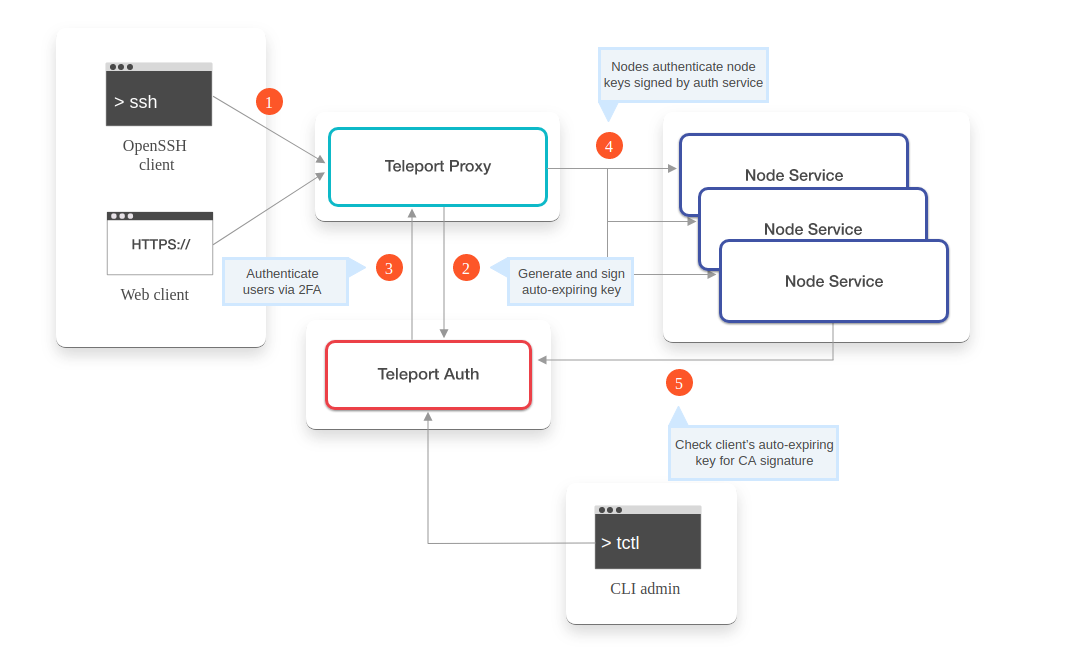 source: https://goteleport.com/docs/architecture/overview/
source: https://goteleport.com/docs/architecture/overview/
- Initiate Client Connection
- Authenticate Client
- Connect to Node
- Authorize Client Access to Node
- Grant User User Access
Quick Teleport Demo
- You can install teleport from the binaries
- As root, create a directory to keep its data and start teleport service
$ mkdir -p /var/lib/teleport
$ teleport start
If it is successful, you will see the below output.
[AUTH] Auth service is starting on 0.0.0.0:3025.
[PROXY] Reverse tunnel service is starting on 0.0.0.0:3024.
[PROXY] Web proxy service is starting on 0.0.0.0:3080.
[PROXY] SSH proxy service is starting on 0.0.0.0:3023.
[NODE] Service is starting on 0.0.0.0:3022.
- Create a user sign-up token
- Create an OS user
$ useradd demo # if it doesn't exist in OS. Mapping to OS user is required.
$ tctl users add demo
Output:
Signup token has been created and is valid for 1 hours. Share this URL with the user:
https://teleporthost:3080/web/newuser/f8b8e58ae8ee822b21c5d9ea10b7400d
NOTE: Make sure teleporthost:3080 points at a Teleport proxy which users can access.
- Register a User:
This will generate a signup URL where you can setup the 2FA authentication using Google Authenticator app
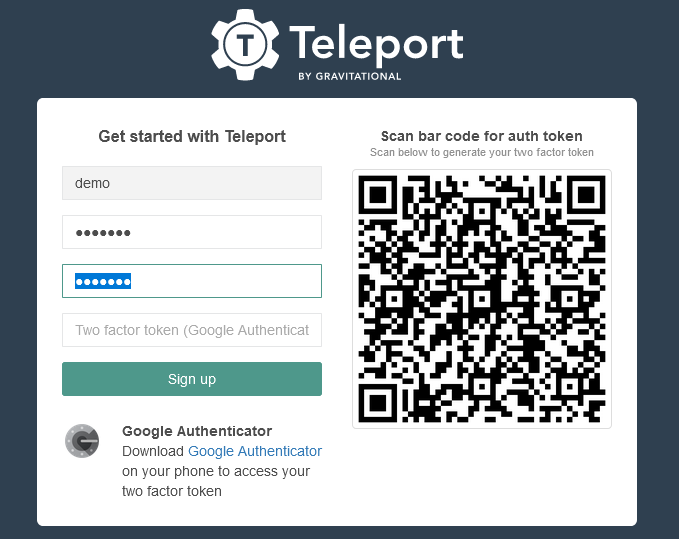
- Login to demo user via teleport proxy
tsh --proxy=localhost--insecure login --user demo # in my demo, teleport proxy is localhost
WARNING: You are using insecure connection to SSH proxy https://localhost:3080
Enter password for Teleport user demo:
Enter your OTP token:
568439
WARNING: You are using insecure connection to SSH proxy https://localhost:3080
> Profile URL: https://localhost:3080
Logged in as: demo
Cluster: *********
Roles: admin*
Logins: demo
Valid until: 2020-05-12 10:41:48 +1000 AEST [valid for 12h0m0s] Extensions: permit-agent-forwarding, permit-port-forwarding, permit-pty* RBAC is only available in Teleport Enterprise
https://gravitational.com/teleport/docs/enterprise
- Using tsh you can do ssh or scp now and even record the session.
PS: You can find more information on achieving security and compliance with Teleport in this blog.
Hope you enjoyed the article. If you have questions, feel free to reach out to me via Twitter.
Looking for help with your cloud native journey? do check our cloud native consulting capabilities and expertise to know how we can help with your transformation journey.
References
Stay updated with latest in AI and Cloud Native tech
We hate 😖 spam as much as you do! You're in a safe company.
Only delivering solid AI & cloud native content.

